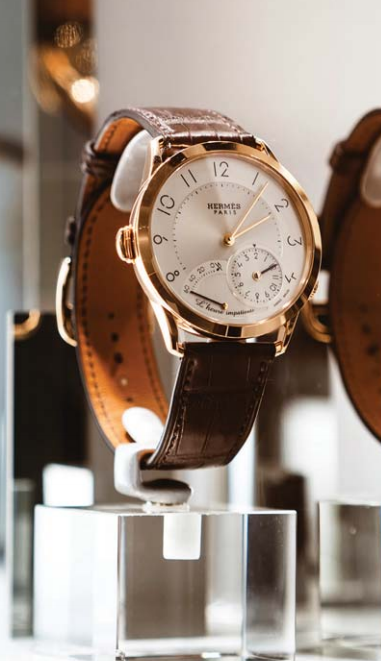.pdf+-+Foxit+PhantomPDF+Express+for+ASUS.png)
The photo booth lets visitors try their hand at juggling while a shadow of a bear mimicking their movements is cast on the wall behind

Slim d’Hermès L’Heure Impatiente is designed to heighten the wearer’s sense of pleasurable expectation of the time leading up to a highly anticipated event Also on display was the whimsical Slim d’Hermès L’Heure Impatiente, designed to heighten the wearer’s sense of pleasurable expectation — an “exquisite torture”, they say — of the time leading up to a highly anticipated event, such as a romantic date. Equipped with the Manufacture Hermès H1912 movement, it features an “Impatient Hour” complication at 6 o’clock — the wearer sets the counter to the time of the eagerly awaited event taking place within the next 12 hours. An hour before the event, the mechanical hourglass is set in motion and its progress can be followed. When the time comes, the striking mechanism delivers a velvety-smooth sound. This quirky complication watch is clothed in technical finesse. “People know Hermès as a leather goods maker, a bag maker or for its silk scarves, but not so much as a watchmaker. So, the purpose of this exhibition is also to allow visitors to discover Hermès as a watchmaker, and discover more exclusive pieces within our collection,” says Dordet. ‘More Swiss than Swiss brands’
The 180-year-old brand began its foray into the world of watchmaking about 40 years ago. “Our CEO at the time wanted to start with watches that were simple but very high-end and creative, using the best quality of materials and finishing. So, we began with quartz watches and that’s why from the beginning, Hermès was more dedicated to ladies’ watches,” says Dordet, now based in Switzerland to oversee Hermès’ entire watch business. Recounting the history, he adds: “We were the first French brand to establish [a horological presence] in Switzerland 40 years ago. It took us a lot of time to understand, invest and master the movements to get to where we are now, which is a totally integrated manufacturer in Switzerland — with Swiss know-how and French creativity.”
.pdf+-+Foxit+PhantomPDF+Express+for+ASUS.png) The company started producing men’s watches in the last decade, with its first in-house movement developed in 2011. That is why the brand’s “feminine leg” is much more developed today, with women’s watches comprising 80% of its production of timepieces.
As a result, Dordet finds himself still having to prove the legitimacy of Hermès’ timepieces and Swiss manufacture.
“People who know Hermès love and trust it and understand that it is a very authentic company. But a lot of people don’t expect Hermès [to be] in that field [of watches]. So, we have to develop awareness that we are not doing fashion watches like some other brands that subcontract watches,” he asserts. “We are a genuine French brand with an established manufacture in Switzerland to seriously manufacture watches and be a genuine watchmaker. This is something people often don’t know. It is a challenge, as we are facing big competition — our competitors are pure watch players or watch jewellers.”
Almost everything, from the movements and cases to dials and straps, is manufactured and assembled in-house. Only the sapphire glass casings, says Dordet, are not done internally. “Yes, it took us some time to build this manufacture, but now that it is done, we are much more Swiss than a lot of Swiss [watch] brands,” he adds with a laugh.
He is unable to reveal production quantities, but says the top three product categories in the brand’s portfolio globally are leather goods, which make up about half of all Hermès sales; fashion and ready-to-wear (about 20%); and silk (around 12%). Watches rank around fifth. Dordet is happy with the growth of Hermès’ watchmaking division and feels that it is developing well. “On the retail side, it’s quite a positive trend in our own stores, which account for about 80% of our sales,” he says. In the countries where Hermès watches are distributed by independent retailers, however, business is “far more difficult and still negative”, he notes. The company is therefore in the midst of downsizing its external distribution network. “We keep the good partners with whom we can develop the business, and we downsize the network where the conditions are not favourable for us anymore.”
Growth, like for most luxury brands, is now coming predominantly from Asia. “We are expanding a lot here in Southeast Asia. Thailand is growing well. We already have two stores in Bangkok and will be opening a new one there at the end of 2018,” shares Dordet. The brand is also adding another store to its Melbourne portfolio at Chadstone Shopping Centre, while it will be renovating one of its Singapore boutiques. A new region, says Dordet, would be the Middle East, where Hermès is just entering the market. He is reticent, though, about the new developments watch lovers can anticipate from Hermès’ manufacture. We exchange several coy smiles, followed by a somewhat awkward silence and, finally, he says: “A new men’s line is coming.”
Staying loyal to Hermès’ DNA
The company started producing men’s watches in the last decade, with its first in-house movement developed in 2011. That is why the brand’s “feminine leg” is much more developed today, with women’s watches comprising 80% of its production of timepieces.
As a result, Dordet finds himself still having to prove the legitimacy of Hermès’ timepieces and Swiss manufacture.
“People who know Hermès love and trust it and understand that it is a very authentic company. But a lot of people don’t expect Hermès [to be] in that field [of watches]. So, we have to develop awareness that we are not doing fashion watches like some other brands that subcontract watches,” he asserts. “We are a genuine French brand with an established manufacture in Switzerland to seriously manufacture watches and be a genuine watchmaker. This is something people often don’t know. It is a challenge, as we are facing big competition — our competitors are pure watch players or watch jewellers.”
Almost everything, from the movements and cases to dials and straps, is manufactured and assembled in-house. Only the sapphire glass casings, says Dordet, are not done internally. “Yes, it took us some time to build this manufacture, but now that it is done, we are much more Swiss than a lot of Swiss [watch] brands,” he adds with a laugh.
He is unable to reveal production quantities, but says the top three product categories in the brand’s portfolio globally are leather goods, which make up about half of all Hermès sales; fashion and ready-to-wear (about 20%); and silk (around 12%). Watches rank around fifth. Dordet is happy with the growth of Hermès’ watchmaking division and feels that it is developing well. “On the retail side, it’s quite a positive trend in our own stores, which account for about 80% of our sales,” he says. In the countries where Hermès watches are distributed by independent retailers, however, business is “far more difficult and still negative”, he notes. The company is therefore in the midst of downsizing its external distribution network. “We keep the good partners with whom we can develop the business, and we downsize the network where the conditions are not favourable for us anymore.”
Growth, like for most luxury brands, is now coming predominantly from Asia. “We are expanding a lot here in Southeast Asia. Thailand is growing well. We already have two stores in Bangkok and will be opening a new one there at the end of 2018,” shares Dordet. The brand is also adding another store to its Melbourne portfolio at Chadstone Shopping Centre, while it will be renovating one of its Singapore boutiques. A new region, says Dordet, would be the Middle East, where Hermès is just entering the market. He is reticent, though, about the new developments watch lovers can anticipate from Hermès’ manufacture. We exchange several coy smiles, followed by a somewhat awkward silence and, finally, he says: “A new men’s line is coming.”
Staying loyal to Hermès’ DNA Dordet has spent almost his entire career at Hermès. Twenty-two years, to be precise. I highlight this during the interview and he appears affronted at my allusion to his age. We laugh and I clarify that this is, in fact, quite remarkable and impressive, and that he must have seen the maison evolve enormously during this time. “When I joined Hermès, I was a young pupil and it was a much smaller company. But the obsession with know-how and quality is [still] the same. It’s a company with a longterm vision because it is a family-owned business and not driven by short-term profitability and decisions. That’s why we are very confident about the strategy for our watches and we know it will take time to build this business,” says Dordet, who has been in charge of various métiers (crafts or professions) within the house of Hermès such as textiles, precious leathers, leather goods and luggage. He has also served a seven-year stint as chief financial officer of Hermès International in Paris. He was appointed CEO of the company’s watchmaking division in 2015 and moved to its Swiss headquarters in Bienne. How has his experience in this new world been these past two years? “Still alive,” he jests good-naturedly. “It’s been very exciting, with lots of challenges and challenging periods, but I think we clearly identified our strengths, vision and direction quite rapidly. We are on our way and I’m quite happy about the progress this year, which was the first year where our strategy really paid off.” He is being modest. It began paying off in 2015, when Hermès’ Slim d’Hermès QP was awarded the title of best calendar watch of the year at the prestigious Grand Prix d’Horlogerie de Genève, the annual “Oscars” of the watchmaking world. “Initially, I thought this business would be very different from what I knew before. But it’s the same philosophy, the same strengths that we have in other parts of Hermès, the same recipe. So, we have to be loyal to our DNA, and Hermès is all about know-how, creativity and good service in the retail stores,” he points out. And, of course, tradition. “Our tradition is our know-how and how our products are made. But we not only want to be traditional, we want to innovate and surprise people.”
Jamie Nonis is a lifestyle journalist with an appreciation for all things beautiful This article appeared in Issue 812 (Jan 8) of The Edge Singapore. Subscribe to The Edge at https://www.theedgesingapore.com/subscribe









.jpg)

